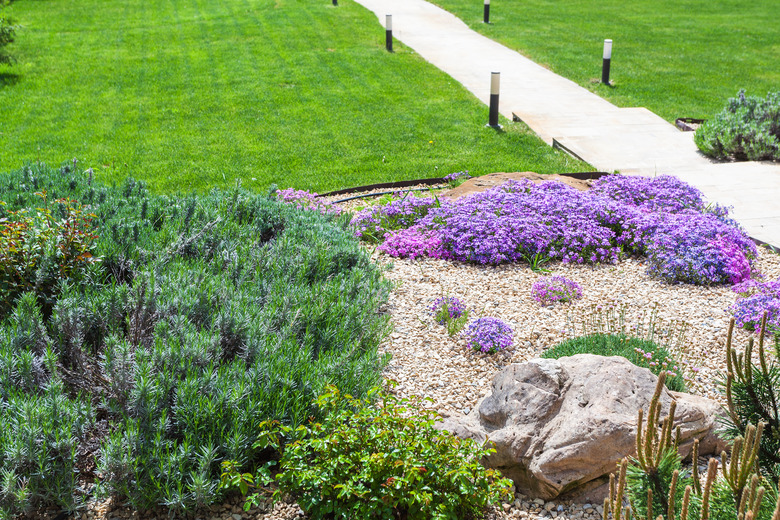Landscaping Ideas For Banks
We may receive a commission on purchases made from links.
Landscaping ideas for banks have to take into consideration the special concerns of sloped areas. Landscaping a bank challenges the most imaginative of gardeners. Often prone to erosion and difficult to mow, landscaping banks requires ingenuity.
Before beginning the landscape project consider the slope of the bank. Is it steep or gently rolling? If the bank slopes sharply, calling a professional landscaper to perform the landscaping might work best. If the bank slopes gently, the addition of constructed terraces or plants will improve the look of the bank and prevent soil erosion. Several garden designs work well for the slanted portions of a yard. Choose zone-hardy plants that have particular appeal when planted on slopes.
Rock Garden Bank
Rock Garden Bank
Rock gardens brighten a landscape with carefree plants and ornamental rocks. Naturally sloping areas are best suited for rock gardens. Rocks help plants thrive by shading the soil and offering a safe harbor for seeds to germinate. Proper drainage in rock gardens increases plant growth and health.
When working boulders into the landscape, dig a hole and place the boulder no deeper than one-third its size to make it look as natural as possible. Use different sizes of rocks in the rock garden for natural appeal. Position the rocks so they look as if they belong in the landscape. Do not attempt to lift heavy rocks without help and proper equipment. Rock suppliers sell a wide assortment of rocks for the avid rock gardener. Other businesses such as nurseries and home supply centers sell rocks as well.
Using native plants in the rock garden provides a low maintenance garden as native plants generally require less care than non-native or hybrid varieties. Plants for the rock garden include sedum, ornamental grasses, native plants, moss, Japanese maple, juniper, sandwort and yarrow. Varying the height, color and texture of rock garden plants creates an attractive landscaped bank. Consider the soil conditions, sun requirements and water needs of individual plants, before purchasing them.
Terraced Bank Design
Terraced Bank Design
Terracing creates a series of level areas that follow the grade of the sloping landscape. Rain runoff spills over terraced slopes without causing harsh erosion. If terracing a bank proves too difficult, consult a professional to do the job. Professionals understand the engineering requirements that must be met to hold the terraces in place.
Some of the materials used in building terraces for banks include landscaping timbers, concrete blocks, bricks, rocks, boulders, decorative landscaping stones and salvaged curbstones. Before starting any landscaping project, check local codes for municipal regulations. Building terraces necessitates additional dirt to fill them. Construct terraces into a series of steps that follow the slope of the bank, then fill them with dirt and add plants, if desired.
Native Plants Bank
Native Plants Bank
One of the best ways to landscape banks is to swathe the bank in native plants. Native plants provide food and habitat for birds and wildlife and have adapted to be hardy and self sufficient. Butterflies and insects thrive on locally grown plants. Indigenous grasses often grow tall and sway gracefully in the wind, as they cover an area. Native flowers planted among these tall grasses add depth and color to a sloping bank. Local plants also help prevent erosion.
Fertilizing native plants isn't usually necessary, as they do not require the tender care that non-native plants need. Areas landscaped with naturally occurring plants do not need mowing. Bear in mind that some native plants may prove invasive; therefore, research is vital for selecting the best plants for an area.
Landscaping Ideas for Banks: Hedges
Landscaping Ideas for Banks: Hedges
Planting shrubs along a bank prevents erosion and offers a lush privacy screen, as the shrubs reach full growth. Planting shrubs that have a strong root system works best for banks. Bushes should be planted in a horizontal arrangement along the sloping bank.
Mixing multi-colored shrubs on the same bank creates an eye-catching look. Some examples of bushes that work well for banks include forsythia, burning bush, flowering quince, evergreen shrubs, and lilacs. Check nurseries for plants best suited for local growing conditions.
